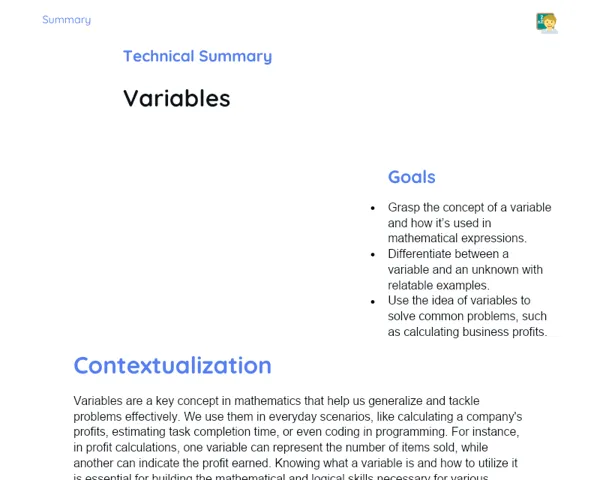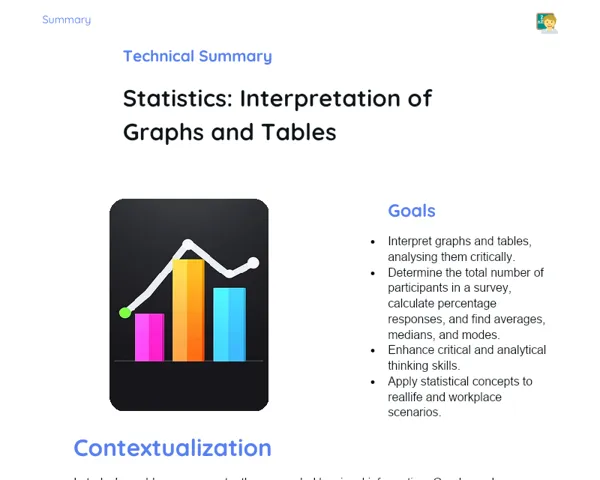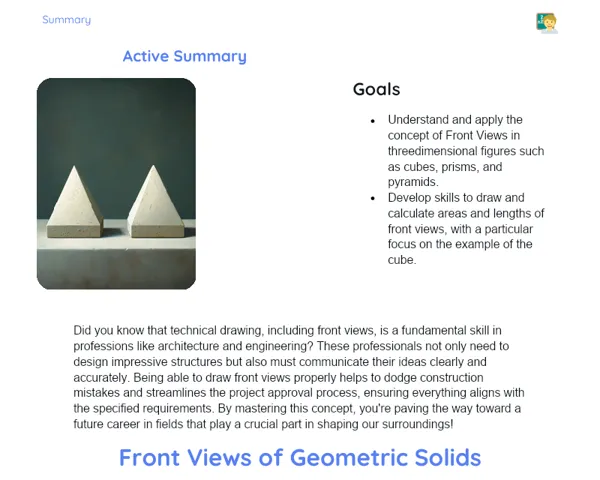Summary Tradisional | 3D Geometric Solids
Contextualization
3D geometric solids are shapes that have three dimensions: length, width, and height. Unlike two-dimensional shapes, which only have length and width, geometric solids can be found all around us in everyday objects like boxes, tins, and pyramids. These objects are tangible examples of solids that we can see and feel in three dimensions, making them a key part of what our 6th-grade learners study in geometry.
It's crucial to understand the elements that make up a geometric solid, such as vertices, faces, and edges, as this helps us identify and analyse these figures effectively. Vertices are the points where edges come together, faces are the flat surfaces making up the solid, and edges are the lines where two faces meet. By mastering how to identify and count these elements in various solids like cubes, prisms, and pyramids, students can build important skills for problem-solving and spatial awareness, useful across various fields.
To Remember!
Introduction to 3D Geometric Solids
3D geometric solids are shapes that possess three dimensions: length, width, and height. Unlike their two-dimensional counterparts, geometric solids can be observed in numerous objects in our daily lives, such as boxes, tins, and pyramids. These solids we can physically touch and see, which makes them essential for our 6th-grade geometry curriculum.
Grasping the components of a geometric solid—like vertices, faces, and edges—is fundamental for recognising and analysing these figures. Vertices denote the points where edges converge, faces are the flat surfaces forming the solid, while edges represent the lines connecting two faces. By learning to distinguish and count these features in different solids such as cubes, prisms, and pyramids, students hone vital skills in problem-solving and spatial awareness applicable across various disciplines.
-
Geometric solids have three dimensions: length, width, and height.
-
Examples of geometric solids include boxes, tins, and pyramids.
-
Vertices, faces, and edges are essential components of geometric solids.
Definition of Vertices, Faces, and Edges
Vertices are the points where two or more edges meet. For instance, each of the eight corners of a cube is a vertex. Understanding these vertices is crucial as they define the shape and structure of the geometric solid. In prisms and pyramids, vertices also play a significant role in determining the shape.
Faces are the flat surfaces that construct the geometric solid. In the case of a cube, there are six square faces. Meanwhile, a triangular prism features two triangular faces and three rectangular faces. The edges connect the faces, and the shapes of the faces dictate the type of solid.
Edges are the lines where two faces intersect. A cube contains twelve edges, each linking two adjacent vertices and separating two faces. A square pyramid contains eight edges: four at its square base and four connecting the base to the apex. Edges are vital to the structure of the solid as they join the faces and define the solid’s outline.
-
Vertices are the meeting points of edges.
-
Faces are the flat surfaces that form the geometric solid.
-
Edges are the lines where two faces converge.
Identifying and Counting Elements in Solids
To identify and tally the elements of a geometric solid, it's important to closely observe its structure. Begin with the vertices, counting each point where the edges meet. Next, tally the faces, considering each flat surface that constitutes the solid. Lastly, count the edges by determining the lines that connect the faces.
For instance, in a cube, you'll discover 8 vertices, 12 edges, and 6 faces. A triangular prism includes 6 vertices, 9 edges, and 5 faces. A square pyramid has 5 vertices, 8 edges, and 5 faces. This identification and counting practice fosters spatial awareness and insight into the properties of geometric solids.
Consistent practice in identifying and counting these elements across various geometric solids is vital for mastering the subject. Students should be encouraged to use physical models and drawings, which will aid in visualising and comprehending the concepts. Additionally, engaging in hands-on activities and exercises reinforces learning and helps apply these concepts to real-world scenarios.
-
Identifying vertices, faces, and edges is crucial to understanding geometric solids.
-
Counting elements enhances spatial awareness.
-
Ongoing practice is key to mastering the topic.
Examples of Solids: Cubes, Prisms, and Pyramids
Cubes are geometric solids with six square faces, twelve edges, and eight vertices. Each face of a cube is a square, and all faces are identical. Cubes are straightforward and common examples of geometric solids, often found in everyday items such as boxes and dice.
Prisms are geometric solids with two parallel and congruent bases connected by lateral faces that are parallelograms. For example, a triangular prism has two triangular bases and three rectangular faces. The quantity of vertices, edges, and faces in a prism depends on the polygon forming its bases.
Pyramids are geometric solids featuring a polygonal base and triangular lateral faces converging at a single point called the vertex. A square pyramid, for instance, has a square base and four triangular faces. The count of vertices, edges, and faces in a pyramid varies based on the base polygon.
-
Cubes possess six square faces, twelve edges, and eight vertices.
-
Prisms have two parallel identical bases, connected by lateral faces.
-
Pyramids have a polygonal base with triangular lateral faces that converge at a single vertex.
Key Terms
-
3D Geometric Solids: Shapes that possess three dimensions: length, width, and height.
-
Vertices: Points where two or more edges converge.
-
Faces: Flat surfaces constituting the geometric solid.
-
Edges: Lines where two faces meet.
-
Cubes: Geometric solids with six square faces, twelve edges, and eight vertices.
-
Prisms: Geometric solids with two parallel and congruent bases joined by lateral faces which are parallelograms.
-
Pyramids: Geometric solids featuring a polygonal base with triangular lateral faces meeting at a common vertex.
Important Conclusions
In this lesson, we explored 3D geometric solids, concentrating on the essential concepts of vertices, faces, and edges. We delved into practical examples such as cubes, prisms, and pyramids, learning to identify and count their elements. This knowledge is vital for improving spatial awareness and for effectively solving geometric problems.
Furthermore, we discussed the role of geometric solids in various fields, such as engineering, architecture, and design, underscoring the real-world relevance of these concepts. The understanding gained empowers students to recognise and analyse the three-dimensional forms surrounding them, deepening their grasp of geometry.
Finally, we emphasised the importance of continual practice in identifying and counting vertices, faces, and edges in different geometric solids. This practice not only strengthens learning but also equips students to tackle more complex challenges in mathematics and related subjects.
Study Tips
-
Review the concepts of vertices, faces, and edges using physical models or drawings to enhance understanding.
-
Practice identifying and counting the components in different geometric solids like cubes, prisms, and pyramids.
-
Engage with additional resources such as textbooks, educational videos, and hands-on exercises to deepen your grasp of 3D geometric solids.



